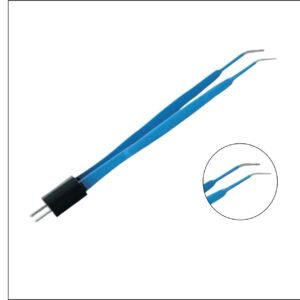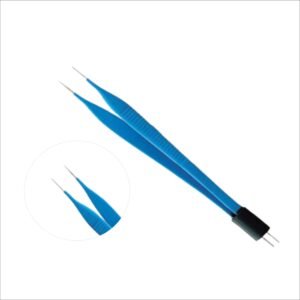Description
Ophthalmic Bipolar Forceps: Precision Tools for Eye Surgery
Ophthalmic bipolar forceps are indispensable instruments in the field of eye surgery, designed to provide surgeons with unparalleled precision and control during delicate procedures. These specialized forceps are used primarily for grasping, manipulating, and coagulating tissue in ophthalmic surgeries, such as cataract removal, retinal repair, corneal transplants, and glaucoma treatment. Their unique design and functionality make them a critical tool for ensuring successful outcomes in complex eye surgeries.
Key Features and Design
Ophthalmic bipolar forceps are characterized by their fine, tapered tips, which allow for precise handling of delicate ocular tissues. The bipolar design enables the forceps to simultaneously grasp and coagulate tissue using electrical current, minimizing bleeding and reducing the risk of damage to surrounding structures. This dual functionality is particularly important in eye surgery, where space is limited and tissues are highly sensitive.
The forceps are typically made from high-quality, non-corrosive materials such as stainless steel or titanium, ensuring durability and sterility. Many models also feature ergonomic handles for improved grip and reduced hand fatigue during prolonged procedures. Some advanced versions come with adjustable settings for controlling the intensity of the electrical current, allowing surgeons to tailor the tool to the specific needs of each surgery.
Applications in Ophthalmic Surgery
- Cataract Surgery: Ophthalmic bipolar forceps are used to remove cloudy lenses and handle intraocular lenses (IOLs) with precision.
- Retinal Surgery: In procedures like vitrectomy or retinal detachment repair, these forceps help manipulate delicate retinal tissues and control bleeding.
- Corneal Transplants: The forceps assist in handling and positioning donor corneal tissue during transplantation.
- Glaucoma Surgery: They are used to manage tissues and control bleeding during trabeculectomy or other glaucoma-related procedures.
Advantages of Using Ophthalmic Bipolar Forceps
- Enhanced Precision: The fine tips and bipolar functionality allow for accurate tissue handling and coagulation.
- Reduced Trauma: The ability to coagulate tissue minimizes bleeding and reduces the risk of damage to surrounding structures.
- Improved Efficiency: Combining grasping and coagulation in one tool streamlines the surgical process.
- Versatility: Suitable for a wide range of ophthalmic procedures, making them a valuable addition to any surgical toolkit.
Maintenance and Care
To ensure optimal performance and longevity, ophthalmic bipolar forceps require proper care and maintenance. This includes regular cleaning, sterilization, and inspection for signs of wear or damage. Proper storage in a protective case is also essential to prevent damage to the delicate tips.
Conclusion
Ophthalmic bipolar forceps are a cornerstone of modern eye surgery, offering surgeons the precision and control needed to perform intricate procedures safely and effectively. Whether used in cataract surgery, retinal repair, or corneal transplants, these instruments play a vital role in achieving successful surgical outcomes and improving patient care. For ophthalmologists and surgical teams, investing in high-quality bipolar forceps is a step toward excellence in ophthalmic surgery.
Hashtags:
#OphthalmicBipolarForceps #EyeSurgery #OphthalmicInstruments #SurgicalPrecision #RetinalSurgery #CataractSurgery #MedicalTools #Ophthalmology #SurgicalInnovation #EyeCare #GlaucomaTreatment #CornealTransplant #Vitrectomy #SurgicalExcellence






Reviews
There are no reviews yet.